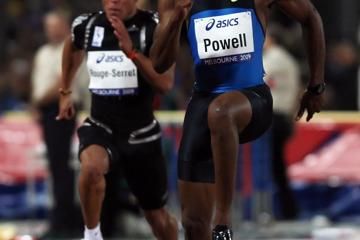Wallace Spearmon en route to a decisive 200m triumph in Eugene (© Getty Images)
With the international indoor and cross country seasons completed, the focus of the athletics world is shifting to the outdoor track and field season with the world’s best athletes set to embark on another world-wide tour as the 2013 IAAF World Challenge series of one-day meetings begins in just over a week in Melbourne on Saturday 6 April.
After Australia hosts the first leg, the 2013 IAAF World Challenge will take in all six IAAF Areas over the course of 15 meetings, ending in Rieti on 8 September. The series will feature meetings in Africa, Asia, Europe (including Moscow, host of this year’s IAAF World Championships), Oceania, North America and South America.
This year’s World Challenge really is an A-to-Z – the first meeting is at Albert Park in Melbourne, and the next-to-last is in Zagreb.
Click here for the calendar of the 2013 IAAF World Challenge
Diamonds not the only things that sparkle
The IAAF Diamond League understandably attracts a large share of the spotlight, but diamonds are not the only objects that sparkle on the international athletics calendar.
The 2012 IAAF World Challenge series saw outstanding performances from, among others, David Rudisha, Usain Bolt and Renaud Lavillenie and introduced or burnished new talents in 800m stars Mohammed Aman and Francine Niyonsaba.
As well, the wider reach of the series enabled some established stars to demonstrate their talents either on their home stage or, at least, within their region.
In Melbourne a year ago, Sally Pearson produced a gem of a run in just her second hurdles race of the Olympic year, skimming faultlessly over the barriers in 12.49. Even the rain which fell through most of the meeting stopped. And Craig Mottram raced to a commanding win over Collis Birmingham in the 5000m, a run which clinched his Olympic selection.
A packed home crowd in Ponce, Puerto Rico, acclaimed Javier Culson’s then world-leading 48.00 seconds in the 400m Hurdles. Bolt and Yohan Blake lit up the Kingston meeting with world-leading times in the 100m (Bolt, 9.82) and 200m (Blake, 19.91).
The IWC meeting provided Bolt with the stage on which to run his first 100m on home soil since 2008.
Drama, did you say; what about Haile Gebrselassie’s (relative) demise in Hengelo when he finished seventh in the 10,000m at the venue where he had run some of his greatest races.
Hometown highlights too
When Paul Cleary, still a couple of months short of his 20th birthday, upset the great Moses Kiptanui in the IAAF GP II (pre-IWC days) Melbourne meeting in 1996, it set off a chain of events epitomising the mix of home performances and international highlights that makes Melbourne’s meeting special to its fans.
Cleary’s 3:38.98 ahead of the distinguished Kenyan trio of David Kibet, Kiptanui and William Tanui announced a fresh local talent and set the 19-year-old on the path to Atlanta Olympic selection.
Stung by the loss, Kiptanui lined up 70 minutes later in the 5000m. Ostensibly he was the pacemaker, but it quickly became clear Kiptanui had other intentions.
Leading all the way, Kiptanui salved his wounded pride with a 13:20.30. The mighty roar as he crossed the line was not for him, however, but for Steve Moneghetti, who produced a very un-marathon like sprint past Paul Bitok to finish second in a personal best 13:25.77.
Those two performances scarcely overshadowed Cathy Freeman’s first sub-50-second 400m. Freeman’s 49.85 was a national record, as was the 48.87 by Rohan Robinson in the 400m Hurdles.
The Melbourne meeting’s record list is dotted with favourite performers. Asafa Powell holds the 100m mark at 10.04, Frankie Fredericks the 200m at 19.92, Jeremy Wariner the 400m at 44.82 and Rudisha the 800m at 1:43.15 – not a bad start.
Others include Craig Mottram (4:50.76 2000m in 2006), Simon Doyle, Colin Jackson, Steve Hooker, Sonia O’Sullivan, Jana Pittman, Emma George, Valerie Adams and Tanja Damaske – an eclectic mix of athletes and events.
A glimpse of what’s in store for 2013
Kenya’s recently-crowned World cross-country champion Japhet Korir and US sprinter Wallace Spearmon, a three-time IAAF World Championships medallist, are just two of the star attractions.
Korir is set to compete alongside Australian 1500m record-holder Ryan Gregson in the men’s 5000m.
A familiar name will return in the 400m. Calvin Smith Jr will take on the one-lap race some 28 years after his father – former 100m World record-holder and two-time World champion at 200m, Calvin Smith Sr – won the 100m at the 1985 Australia Games in Melbourne.
The women’s Pole Vault will see American 4.62m performer Mary Saxer take on Australia’s London Olympic finalist Alana Boyd and Liz Parnov.
In the men’s High Jump, Australia’s Liam Zamel Paez will get a chance to confirm his recent 2.29m personal best against USA’s Dusty Jonas.
Jonas, a Beijing 2008 Olympian, recently returned from a career-threatening Achilles injury, clearing an indoor personal best of 2.34m in Nebraska a year to the day after rupturing the tendon.
The men’s Long Jump promises a match-up between London Olympic gold and silver medallists Greg Rutherford and Mitchell Watt and Australia’s 2010 World indoor champion Fabrice Lapierre.
Unfortunately, after announcing that he would compete, Jamaica’s Asafa Powell has had to withdraw from the 100m during to a hamstring injury.
Len Johnson for the IAAF






